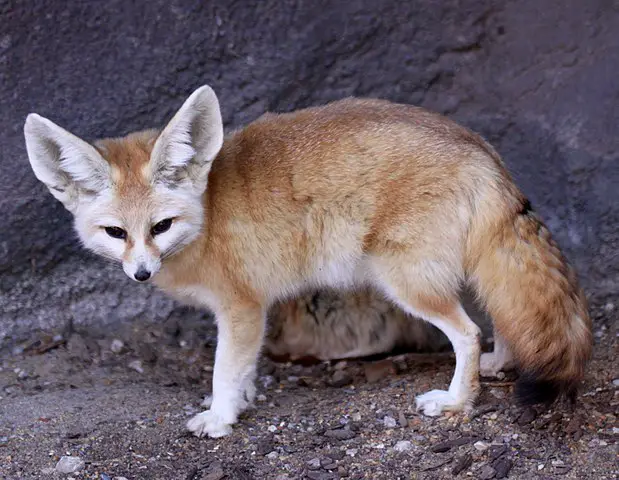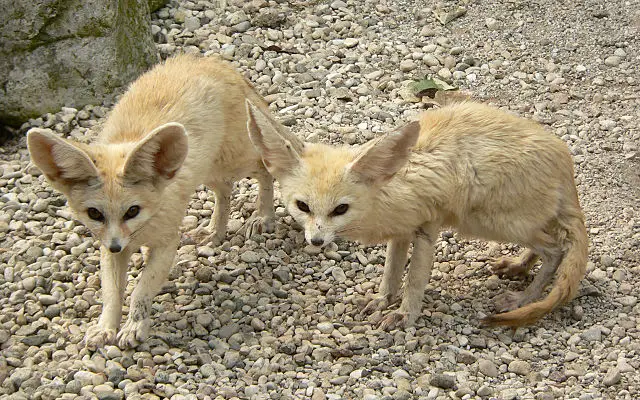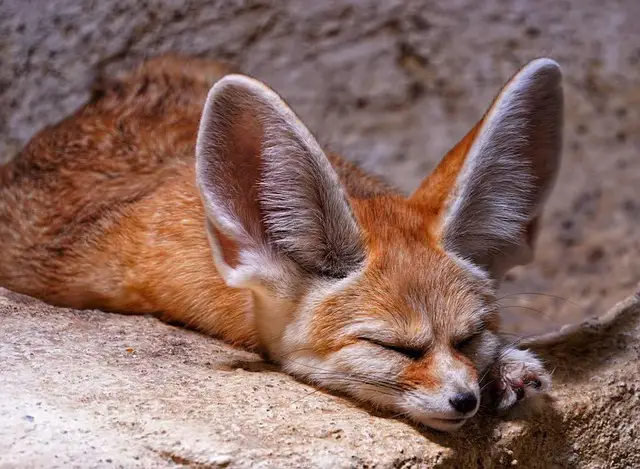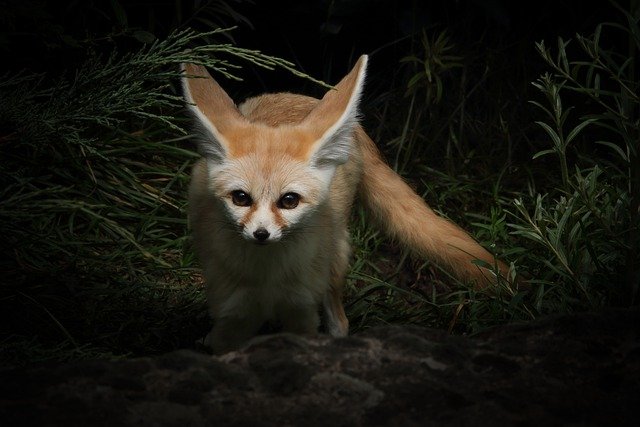Fennec Fox is the smallest fox in the world with distinctive large ears. Due to its large ears, it has an attractive look and catches everyone’s attention. We have gathered a complete set of Fennec Fox Facts For Kids that will provide you with all the Fennec Fox information that you need to know. You are going to learn about is the scientific name, classification, evolution, characteristics, appearance, speed, lifespan, diet, habitat, prey, life cycle, reproduction, babies, adaptations, predators, endangerment, population, and much other fun Fennec Fox Facts For Kids. So read it till the end of this page and do not forget to share it with your friends.
Fennec Fox Facts For Kids
What Is A Fennec Fox – Fennec Fox Species
- Fennec fox is the world’s smallest fox species.
- It is indigenous to the Sahara Desert and the Sinai Peninsula.
- It is also known as the desert fox.
- Fennec fox is well-known for its unusually large ears and cuteness.
- It is a well-adapted animal species to live in a desert habitat with little water and high temperature.
- Fennec foxes are omnivores and eat small animal species and plants.
- According to the IUCN Red List, the conservation status of the fennec fox is Least Concern.

Fennec Fox Scientific Name
- The scientific name of the fennec fox is Vulpes zerda.
Fennec Fox Classification – Fennec Fox Taxonomy
- The following is the scientific classification or taxonomy of fennec fox:
| Kingdom | Animalia |
| Phylum | Chordata |
| Sub-phylum | Vertebrata |
| Class | Mammalia |
| Order | Carnivora |
| Family | Canidae |
| Genes | Vulpes |
| Species | Vulpes zerda |
Fennec Fox Evolution
- Fennec fox belongs to the family Canidae, the members of which are known as canids.
- All canids (including foxes) initially evolved in North America.
- The ancient ancestor of foxes crossed the Bering Strait Bridge around 8 million years ago and spread throughout Asia, Europe, and Africa.
- Fennec fox is a well-known example of microevolution, in which evolutionary changes occur within a species over a short period.
- Two major rules apply to fennec fox evolution:
- Allen’s Rule, describes the evolution of animals based on the climate they live in, and their extremities are adapted to their environment. Fennec foxes evolved to one of the Earth’s hottest environments and have large extremities, especially ears, which helps them to dissipate heat and stay cool. While the Arctic foxes have small extremities to conserve heat.
- Bergmann’s Rule, says that the animals that live in hotter climates tend to be smaller while those living in cold environments tend to be larger. Bigger animals tend to effectively conserve heat than smaller animals. Fennec fox is the smallest fox species and lives in one of the world’s hottest climates.
Fennec Fox Characteristics
- Fennec fox is the smallest species of foxes.
- The most distinguishing characteristic of the fennec fox is its large ears, which help them to stay cool and to locate prey.
- Its beige color coat helps them to blend in with its surrounding.
- Fennec fox has padded paws that are covered with fur, which facilitates its walking on the hot sandy ground.
- It has a dental formula (3.1.4.2/3.1.4.3) ×2 = 42 with narrow and small canine teeth.
What Does A Fennec Fox Look Like – Fennec Fox Appearance
How Tall Is A Fennec Fox – Fennec Fox Height
- An adult full-grown fennec fox has about 20 cm (7.9 inches) height at the shoulders.
What Color Is A Fennec Fox
- Fennec foxes have beige or straw color fur.
- Their nose is black while the tip of their tapering tail is also black.
- The back region of their ears has longitudinal strips of a reddish color, while the edges of the ears are whitish.
- Fennec foxes have large dark eyes.
- Dark reddish strips run from their inner eyes to the sides of their narrow muzzle.
What Is The Size Of A Fennec Fox – Fennec Fox Size – How Long Is A Fennec Fox
- Fennec foxes have sexual dimorphism and male individuals tend to be slightly larger than females.
- Male fennec foxes have head-to-body length from 15.4 to 15.6 inches (39 to 39.5 cm), and tail length from 9.1 to 9.8 inches (23 to 25 cm).
- The head-to-body size of female fennec foxes ranges from 13.6 to 15.6 inches (34.5 to 39.5 cm) with tail length from 9.1 to 9.8 inches (23 to 25 cm).

How Big Do Fennec Foxes Get
- The fennec foxes attain a bigger size of up to 41 cm (16 inches) with up to 1.6 kg (3.5 pounds) body weight.
What Is The Weight Of A Fennec Fox – Fennec Fox Weigh
- Male fennec foxes weigh about 1.3 kg (2.9 pounds).
- While females have 1 to 1.9 kg (2.2 to 4.2 pounds) body weight.
Fennec Fox Ears
- Of all the canid family species, the fennec fox has the greatest ear-to-body ratio.
- Male individuals have about 3.9 inches (10 cm) long ears, while females have 3.5 to 3.7 inches (9 to 9.5 cm) long ears.
- Their ears have whitish edges and are dark reddish at the backside.
- The inside region of their ears has extremely dense hairs, which make the ear canal invisible.
- Big ears keep them cool and provide a keen sense of hearing.
Why Do Fennec Foxes Have Big Ears
- Fennec foxes have big ears to dissipate heat and locate prey under the sand.

How Fast Can A Fennec Fox Run
- According to San Diego Zoo, fennec foxes can run at the speed of 20 miles per hour.
How Long Do Fennec Foxes Live – Fennec Fox Lifespan – Fennec Fox Age
- Fennec Foxes live for up to 10 years in the wild.
- In captivity, they live for up to 13 years.
How Long Do Fennec Foxes Live In Captivity – Fennec Foxes In Captivity
- Fennec Foxes live for up to 13 years in captivity.
- The maximum lifespan of a female fennec fox in captivity was 13 years.
- While the maximum age of male fennec fox in captivity was 14 years.
Where Do Fennec Foxes Live – Fennec Fox Habitat
- The native habitat of the fennec fox is the Sahara Desert and the Sinai Peninsula.
- In the Sahara, they are distributed from Morocco and Mauritania to northern Niger through Egypt.
Where Do Fennec Foxes Live In The Desert
- In the desert, fennec foxes live in small burrows or dens they dig in sandy dunes.
- They also live in wide treeless sand regions with scattered vegetation like small shrubs, grasses, and sedges.
- A den of fennec foxes may be simple or complicated, which depends on the stability of the area where they dig it.
- If a den is in compacted soil, it may be up to 120 m² (1,300 square feet) large. Large dens have many entrances.
- If a den is in soft loser sand, it may be simple with only one entrance.
- In some cases, the dens of the different families are interconnected.
What Do Fennec Foxes Eat – Fennec Fox Diet
- Fennec foxes are omnivores in nature and consume a diet composed of other animals as well as plants.
- They eat small animals like rodents, reptiles (such as lizards, skinks, and geckos), small birds, eggs, and insects (such as grasshoppers, locusts, and others).
- In-plant matter, they consume fruits and tubers.
- They drink water when available but mostly depend on the moisture content of the food.
- Fennec foxes usually hunt alone.
- They can catch and kill prey larger than their body size. In many cases, they are documented catching full-grown rabbits.
- They dig sand to find insects and small vertebrates.
- Some fennec foxes were observed to bury prey for later use.
- In a study, 114 scat samples of fennec foxes were collected in the Algerian Sahara. It contained plant fragments and fruits of the date palm (Phoenix dactylifera), more than 400 insects, remains of mammals, birds, and Squamata reptiles.
- In captivity, they are fed meat, various fruits and vegetables, mice, and insects.
Fennec Foxes Prey
- The common prey of fennec foxes are:
- Small rodents
- Reptiles, like lizards, skinks, and geckos
- Small birds and their eggs
- Insects
How Long Can A Fennec Fox Go Without Water
- The exact time for which a fennec fox can go without water is unknown.
- However, most resources say it simply that they can go without water for a long period.
Fennec Fox Life Cycle
- The life cycle of a fennec fox starts when it becomes sexually mature at the age of about 9 to 10 months.
- They mate to start their own family.
- A litter of 1 to 4 pups born after a gestation period of 50 to 52 days.
- Both the parents cooperatively raised the pups.
- Fennec foxes live for up to 10 years in the wild.
How Do Fennec Foxes Reproduce – Fennec Fox Reproduction
- Fennec foxes usually reproduce only once a year.
- Their mating season is between January and April.
- The male partners become very aggressive in the mating season and mark their territories with urine.
- After mating, the male partner protects the pregnant female and provides her food during the gestation period as well as during lactation.
- Fennec foxes have a gestation period of 50 to 52 days. Sometimes, it also reaches up to 63 days.
- Between March and June, a litter of 1 to 4 pups is born.
- Both the parents cooperatively take care of the pups.
What Is A Female Fennec Fox Called
- A female fennec fox is called a Vixen.

Fennec Fox Baby Facts – Baby Desert Fox
What Is A Baby Fennec Fox Called
- A baby fennec fox is called a Pup or a Kitten.
How Many Babies Do Fennec Foxes Have
- Fennec foxes give birth to a litter of pups.
- A litter may have 1 to 4 babies.
- At birth, their bodies are completely covered with fur.
- They are born blind and start to open their eyes after 8 to 11 days.
- The mother feeds them with her milk.
- About 2 weeks after birth, the pups start walking.
- They are weaned at the age of 9 to 10 weeks.
- They stay with the family even after the birth of a new litter.
- They mature at the age of 9 to 10 months.
Fennec Fox Adaptations – How Do Fennec Foxes Survive In The Desert
Fennec Fox Adaptations To The Desert – Physiological Adaptations
- Physiological adaptations mean changes in the system processes of the animal species, which make it capable of adapting to changes in its habitat’s environment.
- The following are the major physiological adaptations of the fennec fox:
Well-adapted Kidneys
- Kidneys are the vital organs that remove wastes from the body and keep body fluids in control.
- The kidneys of fennec foxes keep more water in the body.
- Their kidneys excrete very concentrated urine and prevent dehydration.
Lowest Basal Metabolic Rate (BMR)
- Basal metabolic rate means the amount of energy per unit of time that the body of an organism needs to function at the rest position.
- Fennec foxes have extremely low basal metabolic rates, which is crucial to surviving in the desert.
- It allows their body to need extremely less water to survive.
Lack of Sweat Glands
- Like other foxes, fennec foxes also do not have sweat glands.
- It helps them to prevent water loss.
Vasoconstriction
- Like other fox species, the body of fennec foxes can constrict blood vessels to maintain body temperature.

Fennec Fox Structural Adaptations
- The following are major structural adaptations of fennec foxes:
Thick and Sandy Color Fur
- Fennec foxes have thick and long fur, which provides them insulation during cold desert nights and also protects them from excessive heat during the day.
- Their sandy color fur blends in with the desert sand and provides them camouflage.
Big Ears
- Big ears of the fennec fox are an important adaptation to survive in the desert.
- Fennec foxes use their ears to dissipate heat and locate prey.
- When the body of a fennec fox gets too hot, the excessive heat moves out through the ears and the body becomes cool off.
- Big ears also provide them with a keen sense of hearing and allow them to track down prey under the sand.
Furry Feet
- Fennec foxes have furry feet that act like snowshoes and protect them from the extremely hot sand of the desert.
- Furry feet also provide them a strong grip on the sand like sneakers. So they can easily turn around and change their direction while running on the sand.
- Their feet also have sharp claws, which they effectively use for digging sand.
Fennec Fox Behavioral Adaptations
- Fennec foxes eat foods of different sources (plants and animals). This behavior increases their survival chances in the desert.
- They are nocturnal and are active at night. This behavior allows them to avoid the hottest part of the day.
- Fennec foxes dig burrows or dens in stable dunes or open areas where they live and flourish. The dens may be simple or complicated depending on the region where they dig it. They take shelter in the dens from the sun exposure and high temperature of the desert day. Staying in the dens helps them to restrict water loss.
- Panting is also an important adaptation of the fennec foxes to cool down. Rather than sweating, panting makes a fennec fox cool its mouth, lungs, and nose through evaporation without losing salt from the body.
What Eats A Fennec Fox – What Are Fennec Fox Predators
- African horned owl is the possible predator of the fennec fox pups.
- There are some anecdotal reports that jackals, caracals, and striped hyenas prey fennec foxes.
- However, nomads say that fennec foxes are fast runners and change directions during running. It is hard for even Salukis dogs to capture them.
Is The Fennec Fox Endangered – Are Fennec Foxes Endangered
- No, the fennec fox is not endangered.
- Its conservation status on the IUCN Red List as Least Concern.
Why Are Fennec Foxes Endangered
- Fennec foxes are not endangered.
- However, there are some threats to their survival in some countries of their habitat range.
- For example, in southern Morocco expansion of settlements and building construction possibly causes the disappearance of fennec foxes in the region. They are usually trapped in North Africa for selling to tourists or for exhibition.
- They are protected in some countries, such as Algeria, Morocco, Egypt, and Tunisia.
How Many Fennec Foxes Are Left In The World – Fennec Fox Population
- The exact population of fennec foxes is unknown.
- However, the IUCN Red List kept fennec fox in the list of Least Concerned species because of their widespread presence in the Sahara desert.
Fennec Fox Pet
- Fennec foxes are commercially breaded and sold as exotic house pets.
- Commercial breeders separate pups from their mothers and hand-raise them.
- Experts say that the fennec fox is a social animal and can be a good house pet in a suitable environment and proper care.
Fennec Fox Pet Legal States
- Keeping fennec fox pets is legal in many states of the USA and many other countries.
- However, it is illegal in many jurisdictions.
- The United States Department of Agriculture classified it as a small wild/exotic canid.
How Much Does A Fennec Fox Cost
- Fennec fox pet costs about $1500 to $2000.
- Fennec fox pets tend to bond with their first owner and do not rehome easily.
- So to buy a fennec fox pet from a commercial breeder, purchasers are usually placed on the waiting list for about a year or more.
Fennec Fox Fun Facts For Kids – Interesting Facts About The Fennec Fox
- Fennec fox is the world’s smallest fox species.
- The ears of a fennec fox can be half as large as its body.
- Fennec foxes do not need to drink water and can go without water for a long period.
- The furry feet of fennec foxes act like snowshoes. It protects them from the heat of desert sand and also provides them excellent grip while walking on the sand.
- The code name of the Mozilla Firefox mobile project is Fennec.
- The name of fennec fox is derived from its Arabic name: fanak (فَنَك).
- Fennec fox is also known as the desert fox because of its native habitat.
- Fennec fox is a social animal and lives in groups. A group of fennec foxes is known as a skulk.
- Fennec foxes make many types of sounds to communicate, such as barks, yaps, howls, chatters, growls, and squeaks.
- The unusually large ears of fennec foxes serve to dissipate heat.
- They have an extremely keen sense of hearing and can detect and locate prey underneath the sand.
- In the canid family, the fennec fox has the largest ear-to-body ratio.
- Fennec foxes run fast and frequently change directions while running. That is why they do not serve as easy catchable prey for predators.
- Fennec fox was depicted in Disney’s 2016 animated movie Zootopia, a character named Finnick. When the movie became popular, Chinese kids begged their parents to acquire a fennec fox as a pet.

What Is The Difference Between A Fennec Fox And A Panther
- A panther or black panther is the black color variant of any Panthera (big cat), especially of the jaguar or leopard.
- A fennec fox and a panther are different animal species.
- Panther is a big cat and belongs to the genus Panthera within the family Felidae.
- While fennec fox is a fox and belongs to the genus Vulpus within the family Canidae.
What Is The Difference Between Fennec Fox And Leopard
- A fennec fox and a leopard are different animal species.
- The Fennec fox is a fox while the leopard is a big cat.
What Is The Difference Between A Cheetah And A Fennec Fox
- A cheetah and a fennec fox are completely different animal species.
- Cheetah is a large cat belonging to the genus Acinonyx and native to central Iran and Africa.
- Fennec fox is a fox belonging to the genus Vulpus and native to the Sahara Desert and the Sinai Peninsula.
